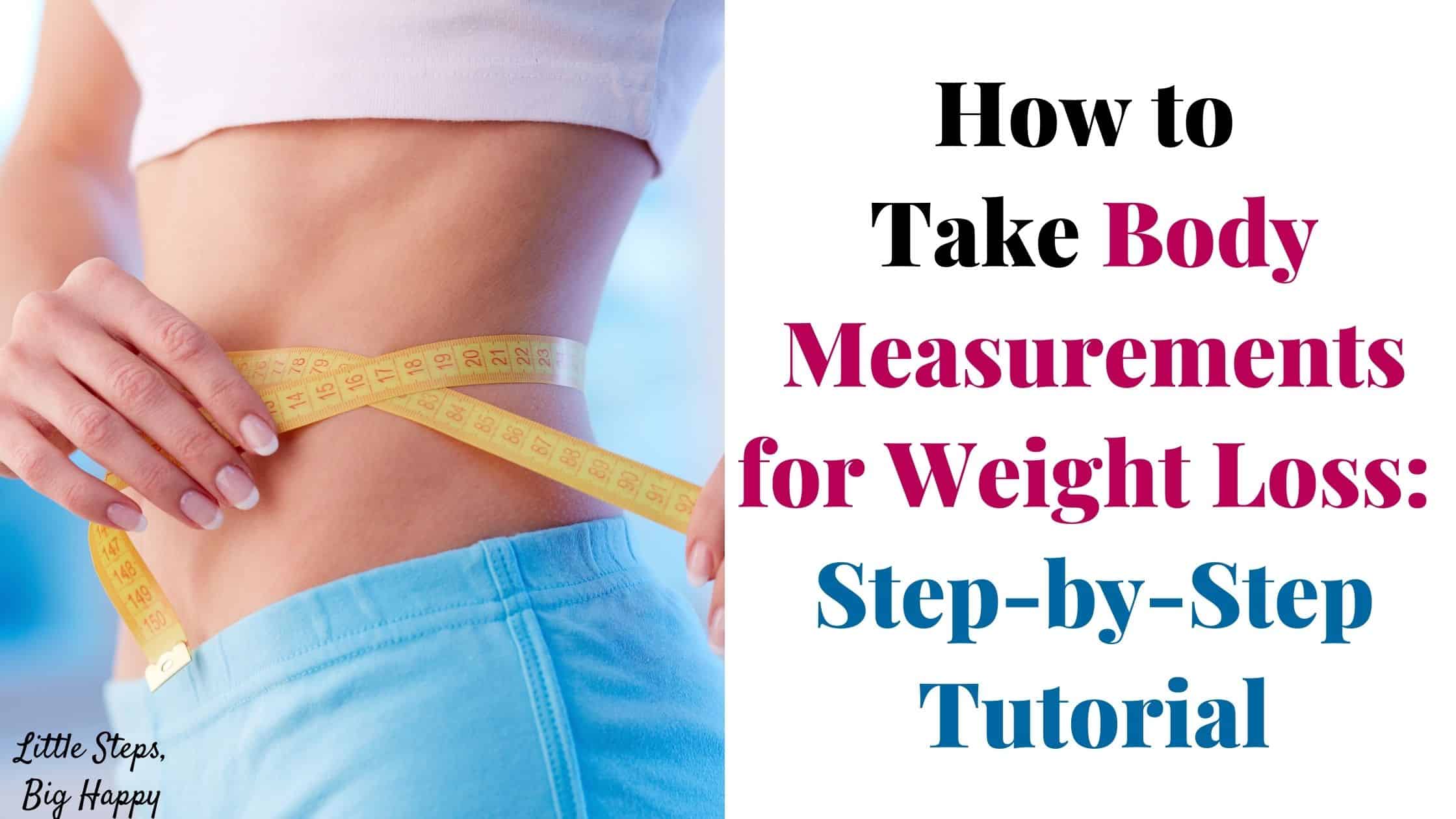One of the things I have learned on my weight loss journey is how important it is to track your progress. One great way to track that progress is by taking body measurements for weight loss.
Taking your body’s measurements is great because it’s typically a lot more reliable and consistent than the scale. Having results that truly reflect your hard-won efforts is a lot more encouraging and motivating as you go along.
Disclosure: This post may contain affiliate links which I’m happy to promote. All thoughts and opinions are my own. Much love & thank you for your support. 🙂 To learn more about my policy, click here.
Contents
What to Know Before You Get Started
Before you get started tracking your body measurements, I want to make sure we cover a few things.
1.) Your measurements will probably fluctuate a bit. As you lose weight and your body changes, you might see losses in places you didn’t expect and gains in some others. That’s all a normal part of the process of losing fat and gaining muscle.
2.) Results take time. Healthy, natural weight loss doesn’t happen overnight. It might take a few months to see really significant progress. That’s ok! At the end of your journey, you won’t complain about how long it took you, you’ll just be happy you did it.
3.) Leave the drama out of it. Guilt, shame, and self-judgment make the whole experience of losing weight 10 times harder. It’s really hard to make positive change from a negative mindset.
Use your measurements as data to help point out what’s working and what isn’t. Then keep moving forward.
How to Take Body Measurements for Weight Loss
So let’s go over everything you need to know about how to take body measurements for weight loss. I’m going to cover how to measure your arms, waist, calves, chest, hips, and thighs.
As you’re measuring, make sure you’re using flexible measuring tape like the one below.
If you only have a retractable measuring tape, typically used for handiwork, you can still make it work.
Grab a long piece of string and use that for your measurements. After each one, mark where the ends of the string meet and then measure the length of string.
What parts of my body do I measure for weight loss?
The short answer is whichever part of your body you want. There are several different body types and we all carry weight in different places.
The women in my family typically carry extra weight in the hips, thighs, and stomach. I know some women who carry weight in their stomach, chest, and arms.
Wherever you want to see results the most is the part of your body that you should measure.
Arms

For your arms, it’s typical to measure around your bicep. To do this, sit down at a table and rest your elbow on the table.
Make a fist with your hand and bend your elbow toward you until your bicep is flexed. Next, hold the measuring tape around the highest point of your bicep until both ends meet.
Write down your results.
Waist
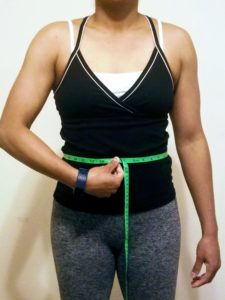
To measure your waist, you’re going to stand up straight and put your hand on your hip. Use your fingers to find the top of your hip bone.
Then extend your thumb up until you can find the bottom of your rib cage. The space in between the top of your hip and bottom of your rib cage is where you will place your measuring tape.
Wrap all the way around your stomach and back until the tape meets. Write down your results.
Calves
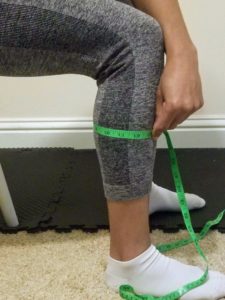
To measure your calves, sit down in a chair and place your foot flat on the ground. Then find the largest part of your calf.
Wrap the tape around and measure where the tape lines up with the starting point. Write down your results.
Chest

To measure your chest, you’re going to want to stand up straight. Wrap the measuring tape around the fullest part of your chest.
Wrap the tape around your back and chest and measure where the tape lines up with the starting point. Write down your results.
Hips

To measure your hips, you’re going to want to stand up straight. Wrap the measuring tape around the fullest part of your hips and booty.
Wrap the tape all the way around your hips and measure where the tape lines up with the starting point. Write down your results.
Thighs

To measure your thighs, you’re going to stand up straight with your feet hip-distance apart. Wrap the measuring tape around the fullest part of your thighs. This tends to be a few inches down from your groin.
Wrap the tape all the way around your thighs and measure where the tape lines up with the starting point. Write down your results.
Tracking Your Measurements
If you’re taking body measurements for weight loss, then you definitely want to be sure that you are tracking your measurements. The whole point of taking your measurements is to be able to note your progress as you start losing weight and inches.
You want a consolidated place to write everything down. I’m personally a fan of good old-fashioned pen and paper.
I like to use a body measurement chart like this one here 
I like to print it out and post it somewhere I can see it often. Seeing it regularly helps keep me motivated and focused on my weight loss goals.
If you prefer to keep things digital, there are plenty of apps you can download for your phone as well. Click to see the top body measurement tracking apps for Google and Android.
Related Posts:
- 5 Surprising Benefits of Journaling for Weight Loss
- 25 Quick Morning Journal Ideas for Weight Loss
- Scale Not Moving? 12 Reasons Why & What You Can Do About it
Tips for Keeping Accurate Measurements
Taking your body measurements for weight loss is a pretty simple process. There are however a few things you can do to make sure you get the most accurate measurements.
The more accurate measurements you take, the better you’ll be able to see and appreciate all the amazing progress you’re making! 🙌
How often should I take measurements when losing weight?
If you’re losing weight consistently, then you could probably take your measurements every 2-4 weeks. If your weight loss is a little more sporadic, then I would suggest taking your measurements every 1-2 weeks.
If the number on the scale is going down, you don’t need to take your measurements as often, because you’re already getting confirmation that what you’re doing is working.
If your weight isn’t going down consistently, then taking your measurements can be a more accurate way to measure your progress. The scale might not change, even though your body composition does.
Meaning you might be losing inches even though you aren’t technically losing weight. However, if you’re just relying on the scale to show your progress, you may completely miss it.
Have the same person take your measurements each time.
For more accurate results, make sure the same person takes your measurements each time. Everyone is going to do it a little differently.
If you, your friend, your partner, and a seamstress all took your measurements, odds are pretty good you would all get a slightly different number.
Depending on how tightly you pulled the measuring tape, where you placed it, and how much experience you have taking measurements is all going to affect the results.
It matters less that it’s done exactly right, but that it’s done the same way each time. Which means the same person each time.
If you feel like it would be hard to get a separate person to do it each time, just go ahead and start off doing it yourself.
Track your numbers in the same place.
Like I mentioned before, you want to make sure that you are tracking your measurements each time. I definitely also suggest that you track them in the same place.
I can speak from experience that having to try to track down that random sticky note, a sheet of paper, or envelope that you grabbed to jot it down real quick is beyond frustrating.
It gets lost, you can’t find it, and now your results have gaping holes and you don’t get an accurate idea of how much progress you’ve made.
Save yourself some frustration and be sure to have a Body Measurement Tracking Chart or app ready to go before you get started.
Don’t hold your breath or suck it in.
While you’re taking your measurements, be sure you don’t hold your breath or suck it in. Now, I know how tempting it can be.
But here’s the thing… you sucking in your belly so you can write down the smallest number possible doesn’t actually change what size you are. And you’re going to eventually have to breathe deeply again and relax.
This process is just about gathering data so you can see what’s working for your weight loss and what’s not. For that, you need your real measurements.
So be sure to breathe normally and keep a natural, relaxed posture.
Keep your circumstances consistent.
Another tip for taking accurate body measurements for weight loss is to keep your circumstances consistent. That means you want to keep as many things the same when you take your measurements as you can.
- Day: try to measure yourself on the same day of the week.
- Time: try to measure yourself at the same time of day.
- Hydration: try to keep in mind how much water you’ve drunk in the last few days before taking your measurements.
- Food intake: keep in mind how much you’ve eaten before taking your measurements.
All of these things can affect your measurements, so try to keep them as consistent as possible. No one’s perfect, so if some things are different, that’s ok! Take your measurements anyways. Some data is better than no data.
But if you can, try to stick to the same circumstances each time for the best results.
How to Take Your Own Measurements
If you’re taking your own measurements like I typically do, the steps are pretty much the same. I just have a few other recommendations.
1.) Do them in front of a mirror. A mirror will help make sure that everything is lined up straight and even.
2.) Do them twice. It’s easy to make mistakes. If you do them twice you can be a little more confident you’re getting the right number.
3.) Do them without clothes on. Clothes add inches, plain and simple. Since you’re doing it by yourself anyways, you might as well get the most accurate results possible.
Beyond that, just follow the same instructions I listed above.
Why Your Measurements Might Fluctuate
As you start to take your body measurements regularly, you will probably notice that they fluctuate a bit. In my experience, this is totally normal.
Besides weight gain, here are some things that could affect your measurements:
Diet
Obviously what you eat is going to affect your measurements. If you’re eating healthy foods that your body processes well, your measurements will probably start to get smaller and smaller.
If you’re eating foods that cause you to bloat, retain water, or struggle to use the bathroom regularly, you’re going to see that in your measurements too.
Muscle Gain
If you’re exercising regularly and really pushing yourself, your body is going to start gaining muscle and hopefully burning fat. And like I mentioned before, the same weight of muscle takes up less room on our bodies than fat.
So in that situation, typically your measurements will start to get a little smaller. However, that’s not always the case.
If you start to build muscle but don’t lose fat, your measurements may start getting larger. To do this, you would have to be doing a LOT of intense strength training while consuming extra protein and calories.
It’s unlikely that would be the reason you’re measurements go up, but it is possible.
Water Weight
If you’re retaining water, then that could definitely be a reason your measurements fluctuate. According to WebMD, here are some reasons you might retain water:
- Too much sodium in your diet
- Sitting or standing too long
- That time of the month
- Certain medications
If hormones or medication are causing you to retain water, just make a note of it and keep up your healthy habits.
If it’s caused by too much sodium or sitting and standing too long, make an effort to reduce the sodium in your diet and try to set a reminder to get up and walk around for a few minutes throughout the day.
Are Your Measurements Normal?
If you’re anything like me, the first thing you want to know after taking your body measurements is “Are they normal?” Especially when we’re losing weight, I think we all want to be sure we’re on track.
I will go ahead and say that unless you have some significant underlying health condition, your measurements are probably normal. They may not be what you would like them to be, but they’re probably fairly common.
I know a lot of women will often get caught up in what are “ideal” measurements. As in what should your measurements be.
I want to go on record and say, that whatever measurements your body has when you reach a weight that makes you healthy and happy are your “ideal measurements.”
But beyond my own personal opinion, a lot of it comes down to your body type.
Different body types
When it comes to the shape of our body, there is no one-size-fits-all. We’ve grown up with the idea that as women we should aim for an hourglass body shape. Big bust, small waist, and big hips.
The reality is, we’re not all built to have that type of body. Even when we’re are at a healthy weight. This is why I don’t want you to get too caught up in whether your measurements are “normal” or “ideal.”
Your healthy, normal, ideal measurements are not going to look like mine, your friends, or anyone else’s.
However, I do think it’s helpful to understand the different body types so you can better understand your own body. I did some research on Infinite by Style Theory on four common body types.
Apple: Your body falls into this category if your shoulders or bust are more than 5% bigger than your hips. This typically means you’re bigger up top than on the bottom.
Pear: Your body falls into this category if your hips are more than 5% bigger than your shoulders or bust. This typically means you’re bigger on the bottom than on the top.
Rectangle: Your body falls into this category if your hips and shoulder measurements are within 5% of each other and your waist is within 25% of your hips, shoulders, and bust. This typically means your curves are evenly proportioned and you don’t have a very defined waist.
Hourglass: Your body falls into this category if your hip and shoulder measurements are within 5% of each other and your waist is at least 25% smaller than your hips, shoulders, and bust. This typically means when you have curvy hips and shoulders and a smaller, defined waist.
Can I Lose Inches in Specific Spots?
When you start taking body measurements for weight loss, it can be very tempting to hope you lose inches in one spot and not another. I can definitely tell you for sure that when I started losing weight, I was hoping that I lost weight in my stomach but not my chest.
Unfortunately, we have no control over where our body loses weight. Our genetics are going to determine that and it will typically fall in line with what kind of body type you have.
For example, my body tends to carry weight in my hips, thighs, and stomach. As I started losing weight, that was the last place my body lost fat.
And when I’m not diligent with my eating habits and exercise, it’s the first place I start to put it back on.
It would be nice if we had ultimate control about where we lost weight and where we didn’t, but the long-term effects of creating a healthy and fit body have definitely been worth it anyway, in my opinion.
Measurements and Clothing Sizes
A common goal for women who are losing weight is to get down to a certain clothing size. It was certainly something I was aiming for when I started losing weight.
However, I want to caution you that your measurements probably won’t always line up with whatever size you’re hoping to be. I don’t want you to work so hard and think that when you finally hit a certain number on the measuring tape or scale that you will magically be able to wear the size you want.
It might not work out that way and it has nothing to do with you. It has to do with clothing manufacturers. Clothing sizes vary drastically depending on the brand.
Here are size charts for 4 different pairs of shorts off of Amazon. As you can see, they all have varying measurements for the exact same sizes.
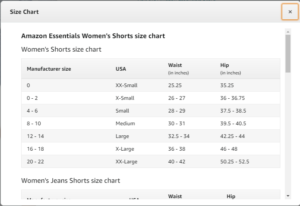


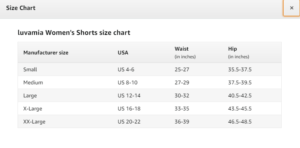
If your goal is to get down to a certain clothing size, I suggest you buy a pair of the clothes you want in that size and just keep trying it on periodically. You can let your measurements just be a sign of the inches you’re losing and progress you’re making.
Why Have My Measurements Changed but My Weight Hasn’t?
It is very common to hit weight loss stalls or feel like you’re not making any progress when the scale doesn’t go down. As we lose weight, a lot of the time we are simultaneously gaining muscle. Especially if exercise is a big part of your weight loss.
When that happens, the fat on our body is replaced by muscle. And the same weight in fat takes up more space on our body than muscle does.
So while you may be losing fat and gaining muscle, the scale might not show much of a difference. But your measurements certainly will!
Tracking Your Body Fat
Tracking your body measurements for weight loss is a great way to keep up with your progress. However, if you want to take it another step further, you can track your body fat percentage.
Your body fat percentage is how much of your body is made up of fat and is a very accurate measure of your body composition.
The easiest way to determine your body fat percentage is to take your measurements and put them into a body fat calculator. It will quickly give you back your body fat percentage as well as whether your results are within the normal range or not.
Conclusion
Well, now you know how to measure and track your body measurements for weight loss. Tracking your measurements is a great way to build some non-scale victories and help keep you motivated and inspired on your weight loss journey.
Are you ready to start tracking your body measurements for weight loss? If you do, tell us about it below or email me at Candice@littlestepsbighappy.com. Follow me on Pinterest for more weight loss tips and advice.
Looking for more weight loss tips?
- How to Set Health and Fitness Goals for Weight Loss
- How to Keep a Food Journal for Effective Weight Loss
- 10 Simple Tips to Help You Lose Weight on a Budget
- 7 Simple Tips to Avoid Holiday Weight Gain This Year
- 7 Quick Weight Loss Tips for Busy Moms
- 9 of the Best Morning Habits for Weight Loss
- 10 Habits You Need to Break to Lose Weight for Good
- 21 Small Diet Changes to Lose Weight for Good
- 5 New Year’s Resolutions to Lose Weight This Year
- 5 Ways Coaching for Weight Loss Speeds Up Your Progress
- How to Lose Weight Without Starving: Smart Tips to Try Today!
- Scale Not Moving? 12 Reasons Why & What You Can Do About it
Pin this for later!!


You might also like…




I’m a busy mom of 3 turned Health and Fitness Coach and Self Defense Instructor. I help inspire other moms to reach their health, fitness, and weight loss goals. You can usually find me chasing my kiddos around, training Brazilian Jiu-Jitsu, or sneaking away to read romance novels. About Me

